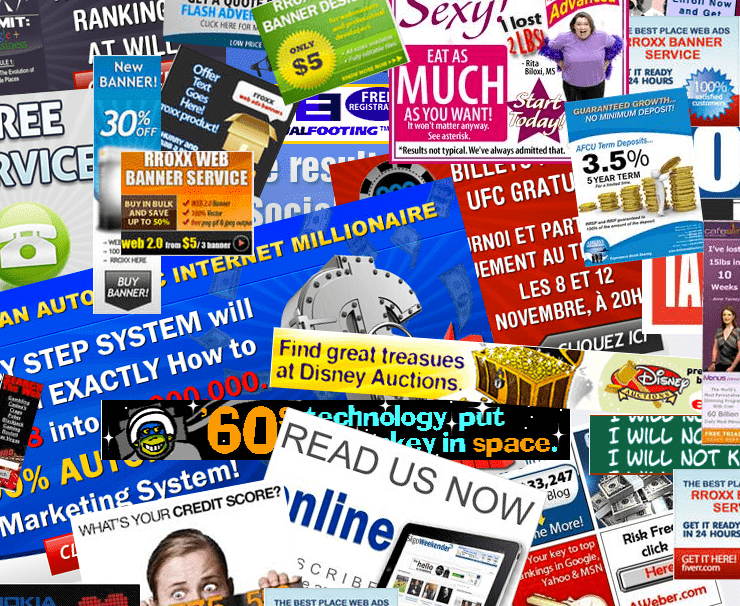What jobs does advertising do?

Advertising on the web is easy… just calculate how much money a customer is worth, then find a way to advertise where you win customers for less than that amount. Voila! A money factory. Right?
This tired logic is so embarrassingly simplistic that it wouldn’t be out of place in a children’s board game, yet the idea still gets frequently re-discovered by self-titled experts. There’s plenty of problems with the approach; the main ones being that the high volume channels are incredibly competitive (i.e. $$$), and the low volume channels simply aren’t enough to build a business upon.
Then there is the fact that this is a self-affecting system. The customers you get through advertising channels often have a different lifetime value to those you acquired through more engaging channels (e.g. inbound marketing), which means that your model can collapse like a house of cards.
Finally you’re also competing with the law of shitty click-throughs. Over time, every advertising technique becomes over-priced or useless.
Why do you advertise?
James Webb Young stated five reasons companies advertise their products: to familiarise, remind, spread news, overcome inertia, and to add a value not in the product. Let’s drill into the first three of these today, we’ll tackle the last two in the next post.
Familiarise users with your product
No matter how good your product is, customers will only buy it when they actually need it. But this doesn’t mean you should only advertise to buyers–far from it. You can win mindshare by making your product the only choice when the need arrives. I see this all the time with Intercom installs. Someone signs up and takes a look around, only to return 8 months later and install it on a massive web app.
This can’t be just name recognition. It has to be name combined with the job the product does. Everyone knows who IBM are, but only a minute subset know why they might hire them. Conversely, if you’ve heard of Mailchimp, you already know what it does and, when you need to run a mailing list, you’re probably not going to shop around. That’s the power of familiarity.
Growing familiarity through online adverts
Introducing a product through tools like Adwords is really tricky. It’s just two short lines of text, which either show right beside your competitors in search marketing or, if you choose the display network, it’ll show next to one of the three P’s of the advertising world: Poker, Pills, and Penis enlargers. This isn’t the association you’re looking for.
Contrast that to a network like The Deck or Fusion Ads, which allow only trusted products on high quality sites, and you can see that there’s a difference between mundane repetition and real familiarity. Other ways to achieve this are sponsoring podcasts or blogs where your product is introduced to the listeners and readers. All you need are the right people receiving meaningful explanations of your product.
Remind users about your product
New products need familiarity, but established products need re-enforcement. The difference is that you don’t need to explain your product when reminding people… you just need to remind them why your product is the right choice.
Re-targetting works well to keep your product fresh in peoples minds, and is a great complementary tool to techniques like inbound marketing, where the product push isn’t upfront. Networks like Perfect Audience are great for reminding previous visitors about your product and what it does.
Promoting news about your product
Spreading news effectively is a great way to get attention for your product. However, what most product owners think of as big exciting news is rarely interesting to anyone else. Anyone on the receiving end of press releases knows this all too well.
News stories consist of an event (what just happened) combined with perspective (the journalist’s thoughts), interpretation (what this means for the layman), context (what else is happening in this landscape), and analysis (what is the new state of play).
Good company news has three characteristics: it’s interesting to the public, it’s beneficial to the company, and it isn’t already well known.
Treat company news like a bank account. Everytime you do something interesting, you’ve deposited some news. Some deposits are small (e.g. new feature, new marketing site), some are significant (product launch, 1,000th customer), and some are remarkable ($10M in profits, ).
Each piece of news you generate can, and should, be spent wisely. Lets say you decide to release your revenue figures. You could spend this on front page coverage on mainstream sites such as Techcrunch, ReadWriteWeb, The Next Web, etc or you could spend it poorly by tweeting it.
Fully transparent companies find it difficult to create big news, because nothing is ever new or exclusive. It’s all sitting on the blog. Apple understand this better than most, which is why they deliver their news sparingly and at big events. As Rands noted, it’s not about secrecy, it’s about theatre.
Key ideas: Advertising isn’t just about click-throughs and conversions. You can and should attract people before they’re ready to purchase, and continue to remind them about your brand. Lastly, company news is an advertising budget of it’s own. Spend it accordingly.






